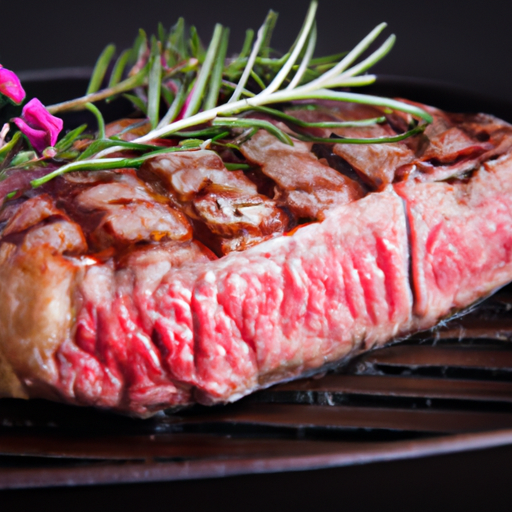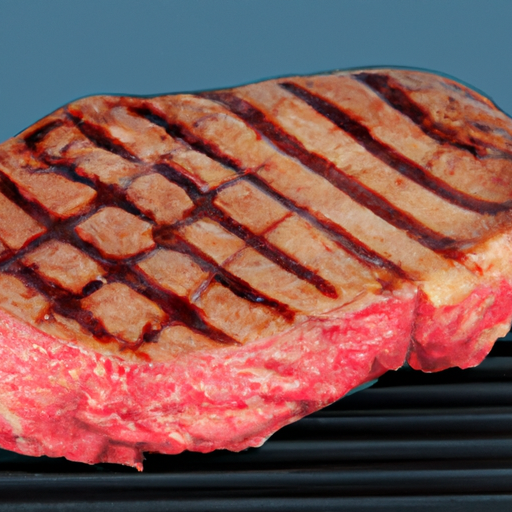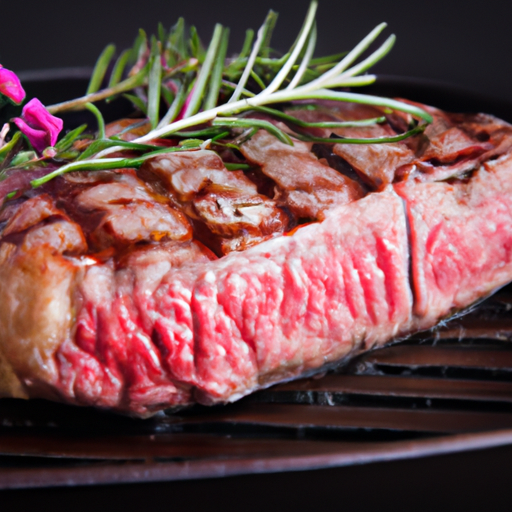If you’ve ever struggled with cooking the perfect steak, then “Perfectly Cooked Steak: A Comprehensive Guide” is just what you need. This comprehensive guide provides all the information you need to cook your steak to perfection every time. With a handy steak cooking chart, you’ll know exactly how long to cook your steak for your preferred level of doneness. Whether you prefer a rare, medium-rare, medium, or well-done steak, this guide will ensure that your steak turns out just the way you like it. Say goodbye to overcooked or undercooked steaks and impress your friends and family with your culinary skills.
Choosing the Right Steak
When it comes to choosing the right steak, there are a variety of factors to consider. One of the first decisions you’ll need to make is selecting the cut of steak. Whether you prefer a tender filet mignon, a flavorful ribeye, or a classic New York strip, each cut offers its own unique characteristics and taste. Take into account your personal preferences as well as the occasion when making your selection.
Another important consideration is the grade of beef. The USDA provides grades for beef based on its quality, taking into account factors like marbling, age, and texture. The grades range from Prime (the highest quality with the most marbling) to Choice and Select. Prime grade steaks are incredibly flavorful and tender, making them ideal for special occasions. However, Choice and Select cuts can still be delicious and are often more budget-friendly options.
When it comes to marbling, this refers to the small threads of fat running through the muscle of the steak. Marbling not only adds flavor but also contributes to the overall tenderness of the meat. More marbling generally means a juicier and more flavorful steak. Keep in mind that different cuts have different levels of natural marbling, so choose accordingly based on your preferences.
Thickness is another factor to consider when choosing a steak. Thicker steaks tend to cook more evenly, as they have a larger buffer zone before reaching the desired internal temperature. Thinner steaks, on the other hand, cook faster and are a good option if you’re short on time. Keep in mind that cooking time and doneness will vary depending on the thickness of the steak.
Preparing the Steak
Preparing the steak before cooking is essential to ensure optimal flavor and texture. One of the first steps is to season the steak with salt and pepper or your preferred seasoning blend. This helps to enhance the natural flavors of the meat. Be generous with the seasoning, as some of it will be lost during the cooking process.
Allowing the steak to reach room temperature before cooking is another important step. This helps to ensure more even cooking, as the steak won’t be cold in the center. Simply take the steak out of the refrigerator and let it sit at room temperature for about 30 minutes before cooking.
Before cooking, it’s crucial to pat the steak dry with a paper towel to remove any excess moisture. This will help to achieve a better sear and prevent the steak from steaming instead of properly browning. A dry surface also promotes the formation of a delicious crust.
If you’re looking to add some additional flavor, you can also consider marinating your steak. While marinating is optional and depends on personal preference, it can add extra tenderness and flavor to your steak. Choose a marinade that complements the cut of steak you’re cooking and allow it to marinate for at least 30 minutes to a few hours, depending on the desired intensity of flavor.

Cooking Methods
There are several cooking methods you can choose from when it comes to preparing steak. Each method offers a unique flavor profile and texture, so it’s worth exploring different options to find your personal favorite.
Grilling is a popular and classic method for cooking steak. It provides a smoky flavor and allows for the beautiful development of grill marks. Preheating the grill is essential to ensure even cooking. Grilling can be done using either direct heat (placing the steak directly over the flame) or indirect heat (creating a cooler zone on the grill). The grill temperature and cooking time will depend on the thickness of the steak.
Pan-searing is another fantastic option when it comes to cooking steak. It involves searing the steak in a hot pan to create a flavorful crust. Choosing the right pan is important. Cast iron or stainless steel pans are great choices as they distribute heat evenly. Preheating the pan is crucial to achieve a proper sear. You can add oil or butter to the pan for additional flavor and to prevent sticking. There are various searing techniques you can use, such as the classic flip and sear or the basting method.
Broiling is a cooking method that involves using the high heat of your oven’s broiler to cook the steak. It’s a great option when grilling isn’t possible. Preparing the broiler pan by lining it with foil and a wire rack helps to promote even cooking and prevent the steak from sitting in its own juices. The oven rack position and cooking time will depend on the desired doneness and thickness of the steak.
Sous vide is a cooking method that involves vacuum-sealing the steak and cooking it in a water bath at a precise temperature. This technique allows for precise control over the cooking process and results in a perfectly cooked steak with consistent doneness throughout. Setting the water bath temperature and cooking time will again depend on the thickness of the steak.
Grilling a Steak
Grilling a steak is a beloved method due to the smoky flavor and attractive grill marks it imparts on the meat. To ensure success when grilling, it’s important to follow a few essential steps.
Begin by preheating the grill to your desired temperature. This will depend on the cut of steak and your desired level of doneness. Gas grills generally take about 10-15 minutes to preheat, while charcoal grills require about 30 minutes.
When grilling, you have the option of using either direct or indirect heat. Direct heat involves placing the steak directly over the flame or heat source. This method is ideal for thinner steaks as it allows for quick and even cooking. Indirect heat, on the other hand, involves creating a cooler zone on the grill where the steak can cook more slowly. This method is well-suited for thicker cuts, as it helps to prevent excessive charring or burning.
The grill temperature is crucial when grilling a steak. For a rare steak, aim for a grill temperature of around 120-130°F (49-54°C). For medium-rare, 130-135°F (54-57°C) is recommended. Medium steaks should be grilled to an internal temperature of 140-145°F (60-63°C), while medium-well to well-done steaks require temperatures of 150°F (66°C) and above.
The cooking time for a steak will vary depending on its thickness. As a general guideline, for a 1-inch (2.5cm) thick steak, grill for about 4-5 minutes per side for medium-rare, 5-6 minutes per side for medium, and 6-7 minutes per side for medium-well. Thicker steaks will require longer cooking times, so adjust accordingly.

Pan-Searing a Steak
Pan-searing is a fantastic alternative to grilling if you don’t have access to an outdoor grill or simply prefer the stovetop method. It allows you to achieve a flavorful crust while keeping the interior tender and juicy.
Choosing the right pan is essential when pan-searing a steak. Cast iron or stainless steel pans are ideal choices as they retain heat well and provide even cooking. Non-stick pans are not recommended as they can prevent proper browning.
Before starting the cooking process, preheat the pan over medium-high heat until it’s hot. This step is crucial for achieving a nice sear on the steak. It’s recommended to heat the pan for about 5 minutes before adding the steak.
Once the pan is hot, you can add oil or butter to prevent sticking and add extra flavor. Just a small amount is needed, and it’s essential to swirl or spread it evenly across the surface of the pan.
There are several searing techniques you can use when pan-searing a steak. The classic flip and sear method involves cooking the steak on one side until it forms a crust, flipping it over, and searing the other side. Another technique is basting, which involves spooning hot oil or melted butter over the steak as it cooks. This helps to enhance the flavor and promotes even browning.
Broiling a Steak
If you don’t have access to a grill or prefer not to use a stovetop method, broiling is an excellent option for cooking steak. It allows for quick and direct heat, resulting in a nicely seared exterior and a juicy interior.
To prepare for broiling, start by setting up the broiler pan. Line the bottom of the pan with aluminum foil to catch any drippings and prevent excessive smoking. Then, place the wire rack on top of the foil-lined pan. This setup helps to promote air circulation and ensures even cooking.
The next step is to position the oven rack. Adjust it so the top of the steak will be about 3-4 inches (7-10cm) away from the broiler element. This distance allows for proper searing without the steak getting too close to the direct heat source.
Before turning on the broiler, preheat the oven to the highest broil setting. This will usually be around 500°F (260°C). Preheating is important to ensure that the broiler is at its maximum temperature when the steak goes in.
The cooking time for broiling a steak will depend on its thickness and the desired level of doneness. For a 1-inch (2.5cm) thick steak, start with 4-5 minutes per side for medium-rare, 5-6 minutes per side for medium, and 6-7 minutes per side for medium-well. Adjust the cooking time accordingly for thicker steaks.
Sous Vide Cooking Method
Sous vide is a cooking method that has gained popularity among culinary enthusiasts. It involves vacuum-sealing the steak and cooking it in a water bath at a precise temperature. This technique ensures a perfectly cooked steak with consistent doneness throughout.
To prepare the steak for sous vide, ensure it is properly trimmed and seasoned. Remove any excess fat or silver skin, and season with salt, pepper, or your preferred seasoning blend. Place the seasoned steak in a vacuum-sealed bag or a sous vide bag and remove as much air as possible before sealing.
Setting the water bath temperature is crucial for sous vide cooking. Different cuts of steak and personal preferences will require different temperatures. As a general guideline, set the water bath temperature to 129°F (54°C) for medium-rare, 135°F (57°C) for medium, and 140°F (60°C) for medium-well. This cooking method allows for precise control over the doneness of the steak.
The cooking time for sous vide steak will depend on the thickness of the steak. For a 1-inch (2.5cm) thick steak, cook it in the water bath for 1-2 hours for medium-rare, 2-3 hours for medium, and 3-4 hours for medium-well. Thicker cuts will require longer cooking times.
Determining Steak Doneness
Achieving the desired level of doneness is essential to enjoy a perfectly cooked steak. There are several methods you can use to determine the doneness of your steak.
Using a meat thermometer is the most accurate way to determine the internal temperature of a steak. For a rare steak, aim for an internal temperature of 125-130°F (52-54°C). Medium-rare steaks should have an internal temperature of 130-135°F (54-57°C), while medium steaks require a temperature of 140-145°F (60-63°C). Medium-well to well-done steaks should be cooked to an internal temperature of 150°F (66°C) and above.
Visual inspection is another method you can use to determine the doneness of your steak. A rare steak will be bright red in the center, while medium-rare steaks will have a pinkish-red center. As the steak cooks further, the center will become more pinkish-brown for medium, brownish-pink for medium-well, and uniformly brown for well-done.
For a quick and simple test, you can use the finger test to determine the doneness of your steak. Gently press the center of the steak with your finger. A rare steak will feel very soft and springy, medium-rare will be soft with a slight spring, medium will have some resistance but still be yielding, and medium-well to well-done will be firm with little to no spring.
Once the steak is cooked to your desired level of doneness, it’s important to allow it to rest for a few minutes before slicing. Resting allows the juices to redistribute throughout the meat, resulting in a juicier and more flavorful steak.
Serving Suggestions
When it comes to serving steak, there are numerous accompaniments and sides that complement the flavors of the meat. Consider pairing your steak with classic sides like roasted potatoes, grilled asparagus, or a fresh salad. Creamed spinach or sautéed mushrooms also make excellent additions.
To take your steak to the next level, consider serving it with a delicious sauce or seasoning. Classic choices like béarnaise or peppercorn sauce are popular options. You can also experiment with homemade herb butters or flavorful compound butters to enhance the taste of your steak.
Presentation is key when serving steak, so don’t forget to pay attention to the details. Consider slicing the steak against the grain for optimal tenderness and arrange it on a preheated plate. Garnish with fresh herbs or a sprinkle of sea salt for an added touch of elegance.
Troubleshooting Common Steak Cooking Issues
Cooking steak to perfection can be a challenge, and it’s not uncommon to encounter a few issues along the way. Here are some common problems and tips to help you troubleshoot them.
If you find that your steak is overcooked, it might be due to excessive cooking time or using high heat. To prevent this, consider reducing the cooking time slightly or lowering the heat. You can also try using a meat thermometer to ensure that the steak reaches the desired doneness without going beyond.
On the other hand, if your steak is undercooked, it may not have been cooked for a sufficient amount of time or at a high enough temperature. Adjust the cooking time accordingly, and if necessary, finish cooking the steak in a hot oven to achieve the desired doneness.
Achieving a proper seared crust can be challenging, especially if your pan isn’t hot enough or if the steak has excess moisture. Ensure that your pan is preheated for a sufficient amount of time before adding the steak, and make sure to pat it dry with a paper towel to remove any excess moisture. Additionally, avoid overcrowding the pan, as this can prevent proper browning.
Dealing with tough or chewy steak can be disappointing. One possible reason for this is selecting a cut that is naturally tougher, such as a flank or skirt steak. To improve tenderness, consider using a meat tenderizer or marinating the steak to break down the muscle fibers. You can also choose a more tender cut or opt for a longer cooking time using a slow-cooking method like braising.
By following these tips and techniques, you’ll be well on your way to mastering the art of cooking the perfect steak. Whether you prefer the smoky flavors of grilled steak, the delightful sear of a pan-seared steak, or the precise control of sous vide, there’s a method that suits your taste and cooking style. So go ahead, choose the right steak, prepare it with care, and enjoy the delicious rewards of a perfectly cooked steak.
